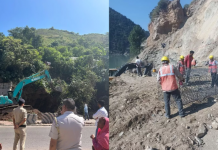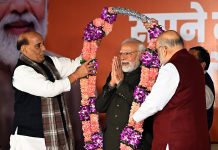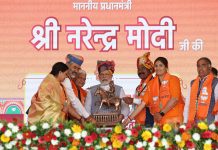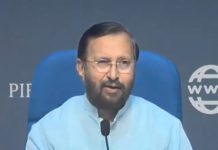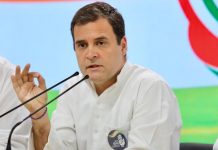 The saffron-clad head priest of Gorakhnath Mutt and Chief Minister of Uttar Pradesh, Yogi Adityanath, has emerged as a champion of “Hindutva” across the country. The Rashtriya Swayam Sevak Sangh(RSS), has excessively trusted his art of master oratory and exceptional potential of influencing targeted Hindu masses in the electioneering of other states.
The saffron-clad head priest of Gorakhnath Mutt and Chief Minister of Uttar Pradesh, Yogi Adityanath, has emerged as a champion of “Hindutva” across the country. The Rashtriya Swayam Sevak Sangh(RSS), has excessively trusted his art of master oratory and exceptional potential of influencing targeted Hindu masses in the electioneering of other states.
Now, the BJP seems to be using Yogi as its ‘Brahmastra’ in the run-up to the 2019 general election, making sure the high profile star campaigner is deployed to places where even the party’s chief orator, PM Narendra Modi, is failing to make his presence count.
Campaigning for BJP in Gujarat, Himachal, Telangana, Tripura and recently held Karnataka elections, Yogi delivered dividends to the utmost satisfaction of BJP’s top strategists who identified pockets where the clout of his religious ‘Nath sect’ following have to be galvanised into its fold. Being head priest of the Gorakhpur-based Gorakhnath temple, named after Guru Goraksh Nāth, famous all over India as a distinguished saint of Nath sect, Yogi is the most sought BJP chief minister for election rallies out of 22 BJP ruled states. In contrast, other BJP chief ministers have been hardly visible in election campaigns or had very little role assigned to them.
Most of Yogi’s election speeches include a soft hint of Hindutva ideology. Here is the excerpt of his speech that he delivered in Karnataka, “While Ram was born in Uttar Pradesh he found his most trusted loyalist ‘Hanuman’ in Karnataka,” By blending the Ram and Karnataka elements, he attempted to make direct connections with the masses. “By mentioning religion and talking of our great ancient heritage, he tried to bridge the geographical and linguistic divide between North and South (Karnataka),” explained his media adviser, Mrityunjay Kumar, who accompanied him during his trail. Campaigning at the communally sensitive Murdeshwar and Kumta towns of the coastal district Uttara Kannada, he targeted Karnataka chief minister Siddaramaiah for protecting ‘Jihadis’ in his rhetoric to polarise voters.
BJP skillfully used his religious metaphor throughout the campaign that had stopovers at various temples and mutts, many of which were connected with the CM’s Nath sect. The party methodically organised his public meetings in coastal areas of the State that was the stronghold of Congress and Karnataka chief minister Siddaramaiah.“Karnataka’s influential Lingayat and Vokkaligas communities have great faith in these mutts which is the reason why the BJP roped in Yogi for Karnataka poll campaign,” said political analyst professor Harshvardhan.
The reflections of the upcoming 2019 parliamentary elections are quite visible behind the series of actions aimed at giving political impetus to the BJP’s strategy to revoke the ‘Ram Temple’ issue once again. Meanwhile, the party is calculating its moves while it awaits the Supreme Court of India’s judgement on the Ayodhya title suits. BJP plans to use it in a big way once again to give momentum to the sidelined Ram Temple movement. This time Sabka Sath Sabka Vikas (Collective efforts, Inclusive Growth) could not be a hit slogan as on performance front people seem to be unsatisfied and small and medium traders, farmers, labours and working classes have been facing undue hardships,” said businessman Vimal Gupta, who had been a strong supporter of BJP. He hoped that this time only Ram can save us (Ab Ramji karege beda paar). He feels, “The alliance between Samajwadi and Bahujan Samaj Party could adversely jeopardise BJP prospects to come back to power.” That is why BJP must realign its strategy to focus on the core agenda of “Hindutva” that flourished its prospects to power in 22 states.
Prime Minister Narendra Modi and UP Chief Minister Yogi Adityanath are working together in a coherent manner to compliment and supplement each other by acting on a well-scripted plan. PM Modi landed in Janakpur, revered as the birthplace of Sita, and along with Nepal Prime Minister KP Oli and inaugurated a direct bus service between Janakpur and Ayodhya as part of a ‘Ramayan Circuit’ to promote religious tourism. He also extended a Rs 1 billion aid to Nepal to develop Sita’s birthplace, Janakpur.
Having come back from Karnataka after a hectic campaigning schedule, an untiring Yogi Adityanath readily reached Ayodhya to welcome 66 passengers from Nepal by the new bus service. They were given warm welcome on the banks of the river Saryu.
The Vishwa Hindu Parishad (VHP) organises a ‘Ram Barat’ (marriage procession) from Ayodhya to Nepal every year to recreate the route taken by Ram to Janakpur, where Sita won him as her husband, according to the “Ramayana”.
By taking an active interest in the development of Ayodhya, the Chief Minister Adityanath has only reiterated BJP’s commitment to building Ram temple. A BJP leader said the bus service would not just help in cementing the bond between Nepal and India, but also restate the party’s commitment to Hindutva. A RSS leader on condition of anonymity said the narrative is likely to grow further as 2019 nears.
“Yogi is a blend of religion and politics. His twin designations as the head priest of Gorakhnath temple and that of UP CM are handy in convincing the masses that Hindutva and development are one,” said Chandramohan, a BJP leader with the RSS background.
RSS ideologues and a larger circle in BJP strongly feel that as a measure of last resort, Yogi Adityanath will be the best bet who can carry forward the baton of Hindutva in the upcoming assemblies and parliamentary elections in 2019, especially with ‘Modi Magic’
diminishing compared to his peak of popularity in 2014. “It would not be surprising if Yogi, having a clean image and mounting following among his ranks and file, could emerge an alternative choice of the mentors for the top leadership,” commented a party functionary.
letters@tehelka.com

